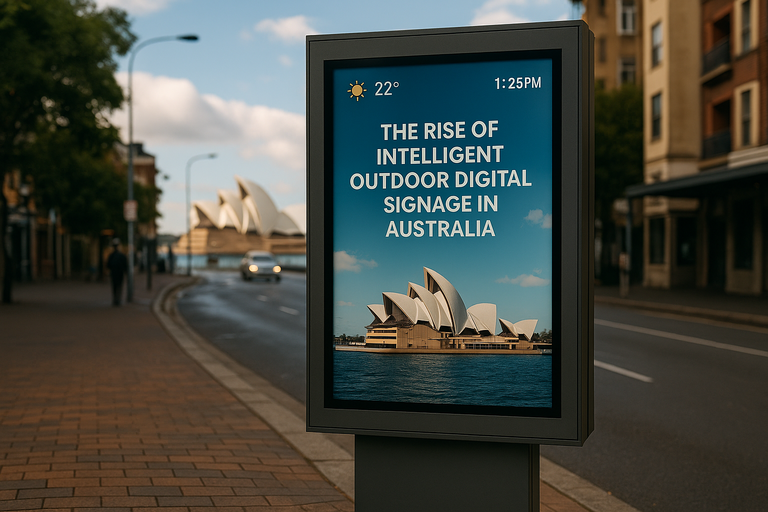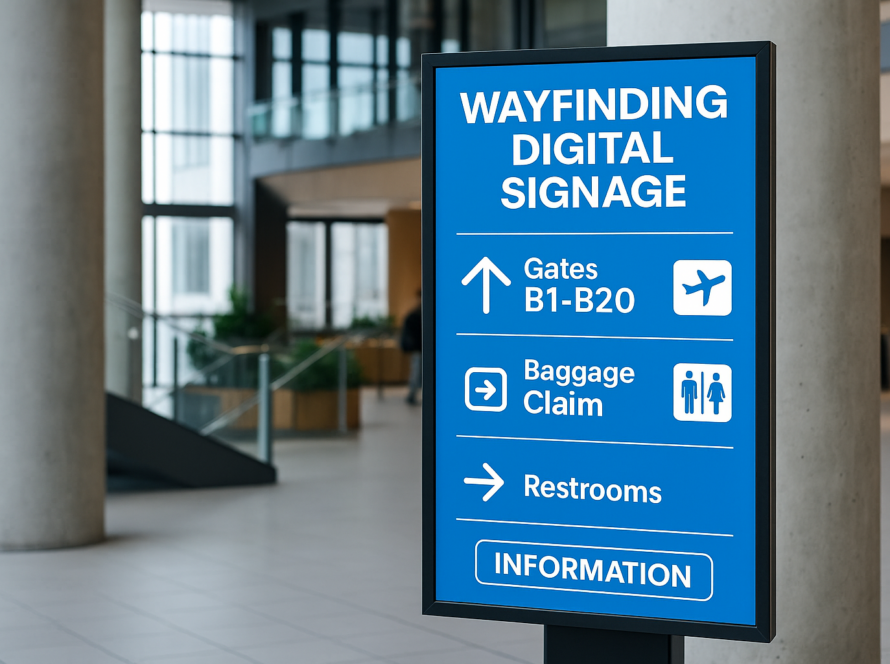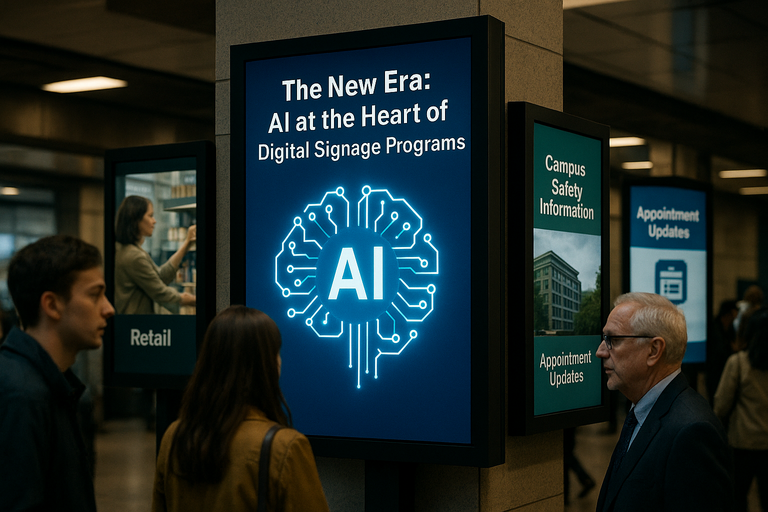The Intelligent Revolution: How AI and Digital LED Signage Converge
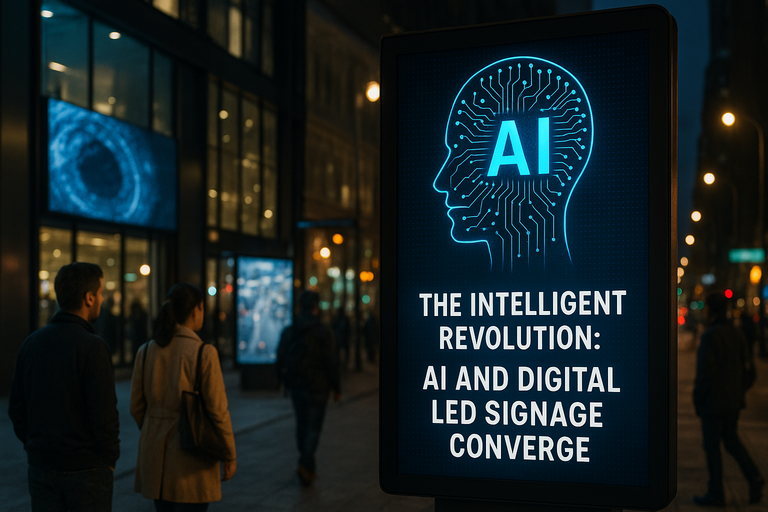
In today’s interconnected, visual-first world, digital LED signage represents the modern pulse of communication. It’s ubiquitous, illuminating retail spaces, guiding us through busy terminals, and captivating crowds on high streets across Australia.
A quiet revolution is underway: artificial intelligence (AI) is rewriting the rulebook. This technology is pushing digital signage from mere eye-catching billboards to context-aware, adaptive, and interactive experiences. This evolution isn’t just about brighter screens or sleeker hardware; it’s about empowering AI-powered digital signage with true intelligence.
At its core, AI and digital signage together form a powerful, symbiotic dynamic. AI-powered content personalisation, audience analytics, and real-time optimisation transform passive displays into active engagement engines. Leading businesses are embracing these advances, expanding possibilities from hyper-targeted retail campaigns that adjust to shoppers’ demographics, to smart city infrastructure that updates emergency routes or public transit schedules on the fly.
In this blog, we explore the transformative intersection of AI and digital LED signage, navigating prominent use cases, real-world examples, and emerging trends. This synergy is redefining the communication landscape across industries, shaping environments where communication feels instinctive, immersive, and human.
AI Unlocks Hyper-Personalisation for Digital LED Signage

The leap from static posters to programmable digital LED signage was impressive, yet still a far cry from true audience-first engagement. AI fundamentally changes this equation. Modern signage platforms now integrate computer vision and machine learning to analyse crowd demographics—age ranges, gender, and even general mood—entirely anonymously and in real time.
This data isn’t just collected; it acts. Content adapts automatically, displaying promotions relevant to a family group in a mall or shifting toward business services as the commuter crowd rolls in. Consider these real-world scenarios:
- Dynamic Retail Windows: AI-powered LED digital signage selects content based on the day’s weather, trending products, and current foot traffic composition. Morning commuters might see breakfast deals, while rainy afternoons pivot screens to warm beverages.
- Airport Wayfinding: AI-driven signage adjusts languages and directional cues to match international arrival patterns detected in real time, streamlining traveller journeys.
- Healthcare Facilities: Similar principles apply, updating wayfinding information and safety protocols for patients and staff based on occupancy and time of day.
This ability to serve the right message, in the right context, at the right moment, makes digital LED signage powered by AI more than a display; it’s an adaptive communication partner.
Powerful platforms like Sign Inspire showcase how combining AI with cloud-based content management enables seamless multi-location deployments. Businesses can schedule content, automate playlist switches based on live data, and track engagement—all from a single dashboard. The result is smarter engagement, increased ROI, and a customer experience that feels curated rather than generic.
For more on the essential components enabling this revolution, read about the future of your digital signage program, player, and LED displays, and see why the choice of platform matters as much as the hardware itself.
Industry Use Cases: AI-Driven Digital LED Signage in Action

Retail remains one of the most transformative arenas for digital LED signage and AI. Smart displays now leverage foot traffic data, dwell times, and product interest metrics to optimise what’s shown, when, and to whom. Imagine a shopper picking up sneakers near a shelf-edge display. The system recognises the interaction, instantly shows customer reviews, promotes a matching hoodie, and offers a real-time discount if the item is purchased now. This level of in-the-moment relevance was inconceivable with traditional signage.
AI-powered digital menu boards are transforming the hospitality sector. Restaurants deploy these to adjust items and pricing automatically based on inventory, weather, or large event spikes. If a favourite dish sells out, the signage instantly highlights alternatives—no manual intervention required.
Other key applications include:
- Healthcare Providers: Use AI signage for queue management, broadcasting estimated wait times, multilingual instructions, and up-to-date health tips tailored to audiences detected in waiting rooms.
- Education: Campuses use AI-powered directory boards that update building maps for events, emergencies, or class changes. Wayfinding becomes dynamic, personalised navigation, supported by real-time integration with calendar and facility management systems.
- Smart Cities: Digital LED signage on streets and transit hubs relays public service announcements, traffic updates, and local weather alerts based on city sensor integration, acting as connective tissue for urban environments.
Dive deeper into specific applications in our use case collection, from gyms and real estate to healthcare and education. For industry-specific insights and strategies, check out resources on maximising sales with restaurant digital signage solutions, elevating property visibility in real estate with smart displays, and boosting wellness and communication through healthcare and physiotherapy clinic signage.
Specs That Matter for Advanced Digital LED Signage
When investing in digital LED signage solutions, understanding key technical specifications is crucial for optimal performance and longevity. These metrics ensure your display delivers impact and reliability in various environments:
- Brightness (Nits): For outdoor digital LED signage, a minimum of 5,000 nits is recommended to ensure visibility in direct sunlight, while indoor displays typically require 800-2,500 nits.
- IP Rating (Ingress Protection): Essential for outdoor units. An IP65 rating signifies protection against dust and low-pressure water jets, while IP67 offers even greater water resistance, crucial for Australian weather conditions.
- Pixel Pitch (mm): This determines image clarity and viewing distance. A smaller pixel pitch (e.g., P2mm) offers higher resolution for close viewing (e.g., retail interiors), while a larger pitch (e.g., P10mm) is suitable for distant viewing (e.g., large outdoor billboards).
- Operating Temperature Range: Commercial-grade digital signage is designed to withstand extreme temperatures, typically ranging from -20°C to +50°C, crucial for diverse Australian climates.
- Uptime & Reliability: Look for solutions guaranteeing 24/7 commercial operation, with an expected lifespan of 8-12 years for LED displays and low failure rates, ensuring consistent communication.
- Contrast Ratio: A high contrast ratio (e.g., 5000:1 or higher) ensures vibrant colours and deep blacks, making content more engaging and impactful.
Prioritising these specifications ensures your digital signage display is fit for purpose, delivering clear, consistent messages regardless of conditions.
The Technology Behind Intelligent Digital LED Signage: LED, AI, and Analytics
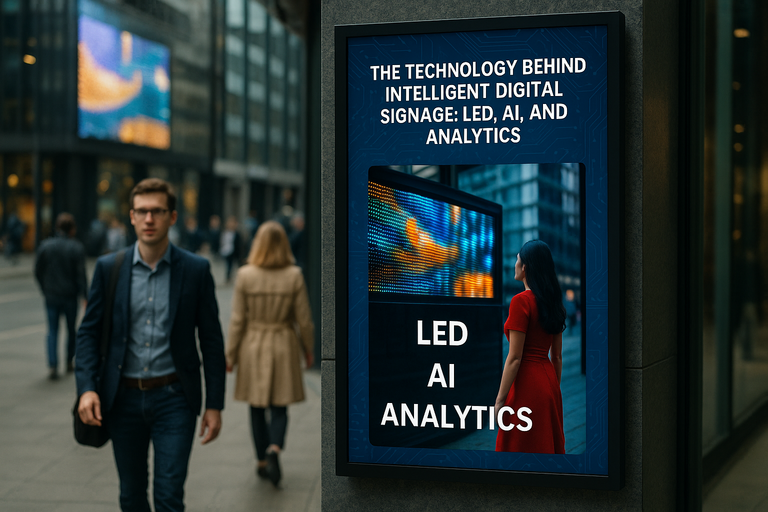
Why does LED remain the superstar in digital signage advancements? LED displays offer remarkable brightness, energy efficiency, and design flexibility. Innovations in direct-view LED have made ultra-wide, seamless installations possible in any environment—from panoramic storefronts to sprawling outdoor billboards.
Equally important, LEDs are more cost-effective and eco-friendly over time, supporting sustainability goals even as content becomes richer and more dynamic. This contributes to a stronger ROI for businesses across Australia.
AI’s Analytical Core
AI’s secret ingredient is analytics—an endless feedback loop that informs better decisions. Attention heatmaps, dwell time analytics, and engagement scoring algorithms help marketers pinpoint exactly what content resonates. The best AI platforms forecast traffic patterns, optimise content schedules, and provide actionable recommendations.
Even content creation is getting smarter: advanced AI tools now generate scalable, context-aware visuals for digital LED signage, removing costly design bottlenecks and enabling rapid campaign iteration.
For those seeking technical guidance, explore SignInspire’s AI-powered features and discover in-depth guidance on how digital signage platforms now measure and enhance visual attention. Thinking of upgrading your system? Don’t miss the extensive digital signage display guide that covers everything from installation best practices to unlocking business potential through smart displays.
Cloud-Based Management & Integration
Hardware is only half the equation. The shift to cloud-based digital signage platforms means businesses can update, personalise, and automate across locations without ever touching a USB drive. Integrations with CRM, POS, inventory, and room management systems close the loop—ensuring your signage isn’t just informed by data, but also helps generate and refine it.
Privacy & Compliance for AI-Powered Digital LED Signage
The integration of AI and analytics into digital LED signage brings immense potential but also critical responsibilities, particularly concerning data privacy. For Australian businesses, adherence to the Australian Privacy Principles (APPs) under the Privacy Act 1988 is paramount. Additionally, global benchmarks like GDPR (Europe) and CCPA (California) inform best practices for responsible data handling.
Key Compliance Considerations:
- Anonymisation: Reputable AI-powered digital signage systems process data anonymously. They analyse patterns and group characteristics (e.g., age range, gender, general mood) without recording or storing personally identifiable information (PII) or images.
- Transparency & Notice: Businesses should clearly inform the public about the use of AI for audience analytics, often through visible notices or privacy policies accessible via QR codes on displays.
- Data Retention: Anonymous, aggregated data should only be retained for as long as necessary for analytical purposes, with clear policies for secure deletion.
- Consent (Where Applicable): While anonymous analytics generally don’t require explicit individual consent, interactive features that collect PII (e.g., email sign-ups) must obtain clear, informed consent.
- Security: Robust cybersecurity measures are essential to protect any collected data from unauthorised access or breaches.
Ethical deployment of AI in digital signage emphasises enhancing experiences rather than surveilling individuals. By prioritising privacy-by-design principles, businesses can build trust and ensure their intelligent displays operate within legal and ethical boundaries.
Emerging Trends: What’s Next for AI and Digital LED Signage?
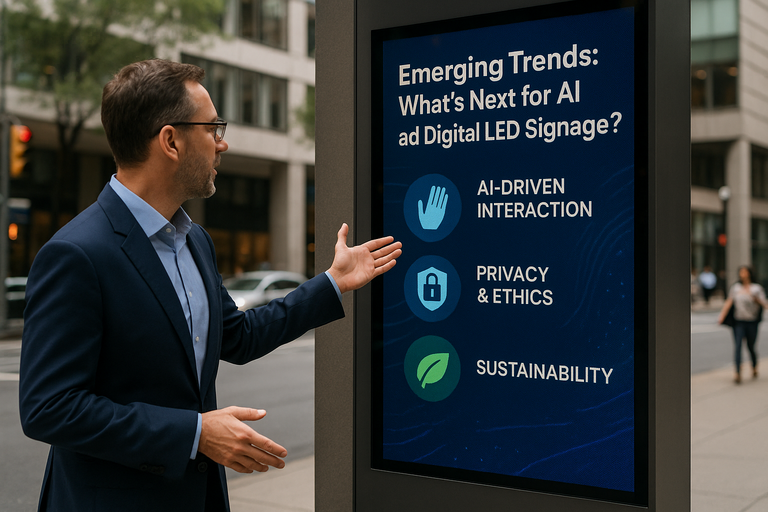
The intersection of AI and digital LED signage is only just beginning to reveal its full potential. Several forward-thinking trends are reshaping the landscape:
- Conversational & Interactive Experiences: Forward-thinking retailers are piloting gesture and voice-based interactions. AI signage can recognise hand waves or prompts and respond with product demos, guidance, or even conversational answers.
- Smart City Integration: Cities are integrating signage with traffic and safety systems, broadcasting live updates to optimise urban flow. The future will see AI signage act as the connective tissue for urban environments, synchronising with IoT systems to drive efficiency and enhance public safety.
- Generative AI Content: The next wave of generative AI promises hyper-dynamic content: menus that update themselves based on available ingredients, event boards that create daily highlights, and displays that generate branded visuals on demand.
- Sustainability Focus: LED’s energy-saving credentials combined with AI-optimised power management are driving greener operations. Maintenance is becoming predictive, with AI systems identifying failing LEDs or connectivity issues before downtime occurs.
Regarding hardware, many businesses compare digital signage displays with consumer TVs. The verdict is clear: purpose-built digital signage offers robust 24/7 operation, remote management, and the analytics backbone essential for future-forward organisations.
For the very latest insights, consult leading sources: the best digital signage blogs on emerging tech and strategy, and timely news on AI breakthroughs in digital displays impacting Australia and beyond.
Best Practices for Digital LED Signage Success: Strategy, Deployment, and Measurement

To unlock the full value of AI in digital LED signage, organisations must approach deployment strategically. A well-planned approach ensures maximum impact and return on investment.
Strategy & Objectives
- Define Clear Objectives: Start with specific outcomes. What will define success (e.g., increased sales, higher footfall, improved engagement, enhanced customer satisfaction)?
- Unified Solution: Select solutions that unify hardware, software, and analytics in one cohesive platform. Ensure flexibility to scale as ambitions grow.
- Content Planning: Plan content for context. Use AI personalisation to avoid overloading viewers, target narrowly, enable rapid changes, and maintain brand consistency.
Deployment & Implementation
- Optimal Placement: Don’t overlook design and placement. Consult resources like in-store display placement guides and wayfinding best practices. Even the most advanced AI signage can fail if screens are hidden from view or content is not legible.
- Seamless Setup: Partner with providers who offer streamlined digital signage installation and ongoing support.
Measurement & ROI
AI transforms digital signage from a cost centre into a measurable asset. Implement robust strategies for tracking performance:
- Analyse Results: Frequently use attention data and engagement metrics (e.g., dwell time, unique views) to refine messaging in near-real-time. Don’t hesitate to A/B test new creative approaches.
- POS Tie-ins: Integrate with Point-of-Sale (POS) systems to directly attribute sales lifts to specific digital signage campaigns.
- KPI Tracking: Establish Key Performance Indicators (KPIs) relevant to your objectives (e.g., conversion rates, average transaction value, reduced perceived wait times).
Invest in training and ongoing support. AI tools are powerful, but human creativity and oversight remain paramount. Equip staff to use dashboards, interpret analytics, and integrate new features as they launch. Work with providers—like Sign Inspire—that offer full support, knowledge sharing, and secure, privacy-respecting deployments.
FAQs About Digital LED Signage with AI
Q: What makes AI-powered digital LED signage different from traditional digital signs?
AI-powered digital LED signage uses advanced algorithms to analyse real-time data (like audience demographics, weather, or inventory levels) and dynamically adjust content. This offers hyper-personalisation and increased relevance, unlike traditional signs that display pre-programmed, static loops.
Q: How does AI ensure privacy when collecting audience data for digital LED signage?
Reputable AI systems for digital LED signage prioritise privacy through anonymised data processing. They analyse patterns and group characteristics (e.g., age range, gender) without recording or storing any personally identifiable images or information. Compliance with privacy regulations like the Australian Privacy Principles (APPs) is standard.
Q: Can digital LED signage improve sales for retail businesses?
Yes, significantly. By delivering hyper-personalised promotions, real-time product information, and interactive experiences based on AI analytics, digital LED signage can increase customer engagement, influence purchasing decisions, and drive measurable sales growth. Many businesses report substantial ROI from intelligent signage deployments.
Q: Is it difficult to manage AI-powered digital LED signage across multiple locations?
No. Modern AI-powered digital signage solutions are typically cloud-based, offering centralised content management systems (CMS). This allows you to update, schedule, and automate content across hundreds of screens from a single dashboard, anywhere in the world, streamlining operations and ensuring brand consistency.
Q: What kind of return on investment (ROI) can I expect from investing in digital LED signage with AI?
ROI from AI-powered digital LED signage comes from increased sales due to targeted advertising, reduced operational costs (no more printing, less manual intervention), enhanced customer satisfaction and loyalty, and improved brand perception. Detailed analytics provide measurable insights into campaign effectiveness, making it easier to track and optimise your investment.
Conclusion: The Future of Digital LED Signage is Intelligent
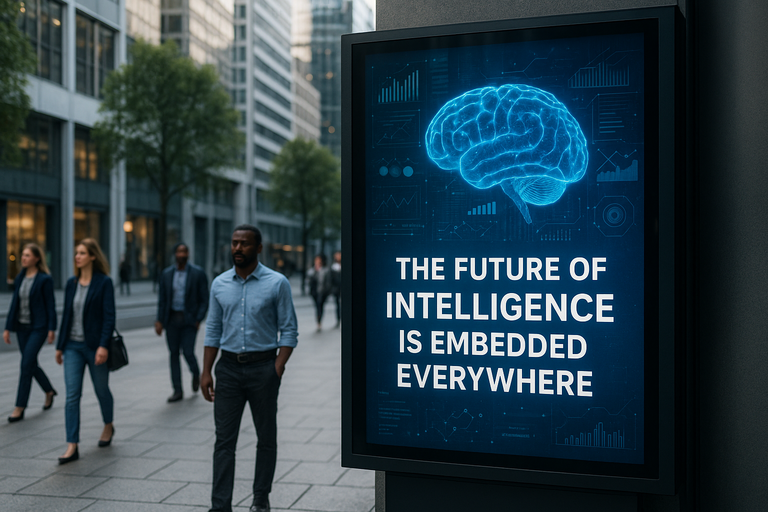
The fusion of AI and digital LED signage signifies a monumental leap forward for communication technology. Every screen can now be as intelligent as its audience and as adaptable as its environment. As advancements in computer vision, natural language processing, and generative design accelerate, expect digital signage to become the nerve centre of both physical commerce and smart cities—responsive, efficient, and increasingly autonomous.
This convergence heralds a future where messages are always timely, always relevant, and always seen in the right way by the right people. For Australian businesses, institutions, and city planners ready to step into this world, the opportunity is immense.
Embrace the intelligent evolution of your communication strategy. The future of digital LED signage is bright, dynamic, and unmistakably intelligent.
Meta Description: Explore how AI is reshaping digital signage with intelligent, dynamic, and adaptive communication platforms.

